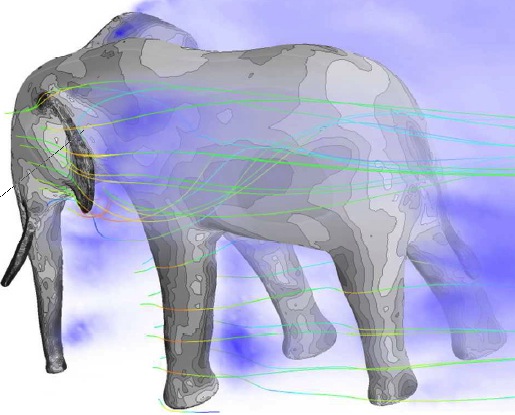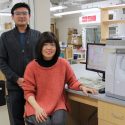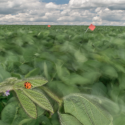A virtual elephant from a marriage of biology, engineering, and art

A new 3-D digital model created by zoology professor Warren Porter can simulate properties of a real elephant.
The solid aluminum cast of an elephant on Warren Porter’s desk has been waiting for 25 years.
With a novel melding of biology, engineering, and art, the 10-inch long cast has now been transformed into a 3-D digital model, capable of simulating interactions between a real African elephant and its physical environment.
Porter, a University of Wisconsin–Madison zoology professor, has long used casts like the elephant to determine physical characteristics such as heat transfer properties and environmental drag forces that would affect their live counterparts. From these properties, he identifies the physical environments in which the animal could live based on its physiological needs.
But he has been limited by his reliance on physical models and complicated wind tunnel experiments. A collaboration with UW–Madison engineering physics professor Riccardo Bonazza, art professor Steve Hilyard, and graduate student Peter Dudley has now developed 3-D animated models and confirmed that the numerical calculations match the physical ones from the wind tunnels.
The results, recently published online in the Journal of Experimental Biology Part A: Comparative Experimental Biology, validate the use of these virtual animals to understand the real ones.
Heat transfer properties have dramatic impacts on all aspects of an animal’s ecology, Porter says, from feeding to breeding. His research focuses on the links between physiology and ecology and how an animal’s metabolic needs — energy use, food intake, heat and cold tolerance — guide where in the world it can live.
He credits the combination of creative interdisciplinary partnerships and powerful technology with expanding the possible questions they can address.
“We have the capability now of designing any kind of animal, whether fossil or living, put it in computational fluid dynamics and get the physical properties that we used to have to do in wind tunnel experiments,” he says.
He has applied his modeling approaches to a wide range of ecological questions related to conservation, agriculture, and even human health. A few examples include forecasting the spread of invasive species, potential impacts of climate change on insect-borne disease, and the suitability of habitat for reintroduction of endangered species. He is currently looking at how different management practices and anticipated climate changes may impact livestock productivity.
“Everything in living systems is interconnected and all those parts have to talk to each other all the time,” Porter says. “So if you’re going to make a change in one thing, you have to have payback somewhere else. Nothing is free.”
The virtual animals make the modeling process much faster and cheaper and reduce the need for live ones. They also open up a whole realm of possibilities previously unthinkable, including working with animals that are rare, logistically challenging, or even extinct.
“No one has done the ecology of any fossil animal because they’ve never been able to study it,” he says. “Now with this virtual reality we are already beginning to reconstruct paleoenvironments and the paleoecology of animals in a quantitative fashion. We can say, how much food did a mammoth need in a day? What would be their distribution limits?”
Tags: biosciences, conservation, research, virtual reality, zoology



